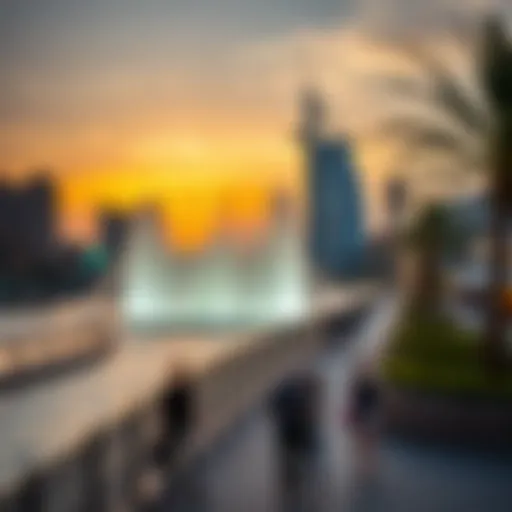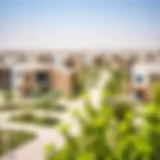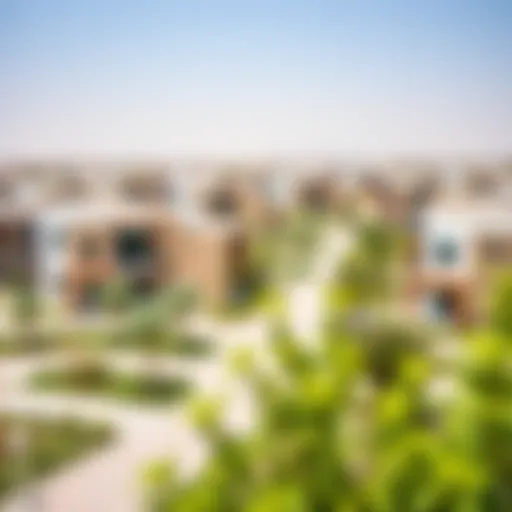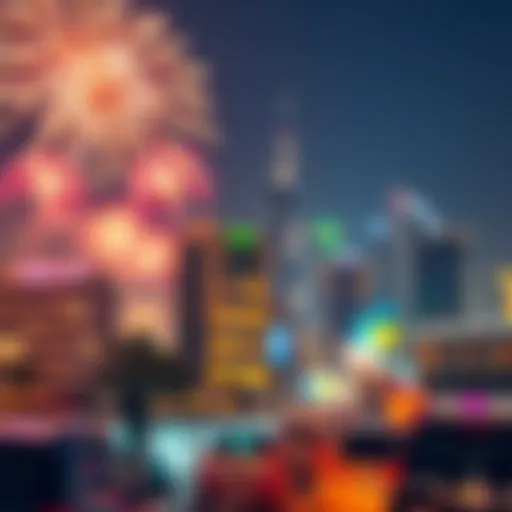Discovering Dubai: A Unique Exploration of Its Wonders
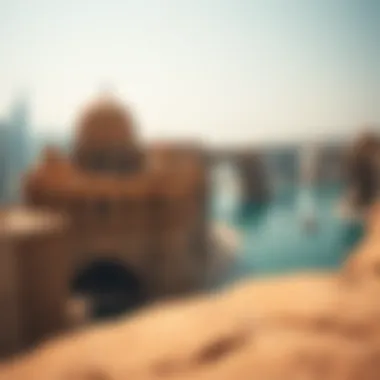

Intro
Dubai is more than just a city; it is an evolving entity that stands as a testament to human ingenuity and ambition. With its impressive skyline dominated by the Burj Khalifa and its sprawling, opulent shopping malls, it captures the imagination of many. Yet, what truly sets Dubai apart is its layered identity, blending traditions with modernity. From bustling souks echoing with the whispers of yesteryears to the sleek, contemporary art galleries nestled in the heart of its urban precincts, each corner of this metropolis presents a story waiting to be told.
As we embark on this exploration, we will peel back the layers of Dubai's attraction, examining the cultural, architectural, and recreational facets that contribute to its unique charm.
This guide aims to help not only curious travelers but also savvy investors navigate the exciting landscape of Dubai. With its growing real estate market, understanding current trends and opportunities is paramount.
The following sections will deliver a comprehensive view into Dubai's multifaceted appeal, detailing key points like cultural landmarks, culinary diversity, and, importantly, investment insights for those considering diving into the commercial potential of this thriving hub. Whether you are a potential investor seeking the best neighborhoods or just a casual visitor eager to explore, there’s something to pique everyone’s interest in the vibrant city of Dubai.
Prelude to Dubai
Dubai, a city that drips with opulence, vibrancy, and innovation, serves as an exceptional case study in how tradition can beautifully coexist with a bold modern vision. Its strategic location as a convergence point for East and West has positioned it as a hub for business, culture, and tourism.
The significance of introducing Dubai lies in understanding its multifaceted identity—a mosaic constructed of skyscrapers like the Burj Khalifa, rich cultural experiences, and diverse culinary offerings. This bustling metropolis has transformed from a small fishing village into a global powerhouse in just a few decades, making it a fascinating subject for investment and exploration.
In this exploration, we will not only highlight Dubai’s architectural wonders and cultural landmarks but also delve into aspects that resonate deeply with investors, expatriates, and homeowners. Understanding this city means recognizing its unique blend of heritage and modern comfort. Its approach to cultural diversity fosters an environment where entrepreneurship flourishes and expatriate communities thrive.
Some key components we will cover include:
- The strategic innovations driving real estate development
- Cultural insights that shape the community
- Culinary diversity that reflects its cosmopolitan population
Ultimately, a thoughtful look into Dubai allows one to appreciate both its past and present, recognizing how its core values of hospitality and progress shape the city's future. As we peel back the layers in the subsequent sections, readers will gain valuable insight into what makes Dubai a truly unique destination—one worthy of both admiration and investment.
"Dubai is a city of contrasts; each facet invites exploration and engagement, providing endless opportunities for discovery."
In this article, we hope to provide a comprehensive guide to Navigating Dubai—an essential resource for those seeking to understand this dynamic destination.
Architectural Wonders
Dubai is a city that seems to reinvent itself at every corner, particularly in the realm of architecture. The skyline of Dubai is an evolving tapestry, knitting together elements of avant-garde design with practicality. Architectural wonders aren’t just about stunning visuals; they symbolize the ambition of a city that aspires to be the best in every domain. This section will take a closer look at some of the most iconic structures, shedding light on their design philosophies, cultural implications, and the experiences they offer.
Burj Khalifa
Overview of its design and height
Burj Khalifa represents more than just a tall building; it is a beacon of human ingenuity. Standing at an astounding 828 meters, it holds the title of the tallest structure in the world. Designed by Adrian Smith of Skidmore, Owings & Merrill, the structure's design is inspired by the Hymenocallis flower, a native of the region. This architectural marvel is not merely a triumph in engineering; its presence on the skyline is a statement about Dubai’s aspirations.
The sheer height of Burj Khalifa influences many facets of urban living and tourism. From the ground up, it incorporates mixed-use elements that blend residential, commercial, and hospitality spaces, making it a lively part of the community. Its crowning achievement is arguably the exterior, clad primarily in glass, which reflects the sun in golden hues. However, this brings up potential challenges with energy efficiency; while it aims to draw attention, the maintenance of such a surface can prove labor-intensive.
The observation deck experience
Visitors are often drawn to the observation deck on the 148th floor; this experience is not just about the view, but the journey up the critical elements of Dubai itself. The ride to the top boasts one of the fastest elevators in the world, gliding within a matter of seconds to unveil unparalleled vistas. From this vantage point, the sprawling desert and the Palm Jumeirah can be seen in their full glory, emphasizing the contrast between natural and man-made wonders.
Although the observation deck allows for breathtaking visuals, the popularity is not without its drawbacks. Long wait times, especially during peak hours, can detract from the experience. Nonetheless, the ability to witness the intricate mosaic of Dubai from such heights is a compelling reason why tourists flock here—making it a pivotal part of the city's identity and an essential stop for any traveler.
Burj Al Arab
Luxury hotel features
Known as the world's only seven-star hotel, the Burj Al Arab perplexes and delights everyone who sets eyes upon it. The hotel's sail-shaped silhouette stands as a testament to luxury, boasting opulent interiors crafted for discerning guests. Features such as private butler services and lavish suites showcase a level of hospitality that is rare in the global hotel industry.
The Burj Al Arab is not simply a place to stay. It encapsulates an experience, with amenities that cater to indulgence, such as fine dining restaurants where chefs offer gourmet meals paired with top-notch service. While these features attract luxury travelers, the costs can be prohibitively high for the average visitor, challenging the perception of accessibility to such iconic landmarks.
Architectural significance
In terms of architectural design, the Burj Al Arab is often considered a global icon. Its construction involved complex engineering solutions, as it was built on a man-made island. This innovative approach not only augments the land area available but also showcases Dubai's boldness in challenging traditional architectural paradigms. The design incorporates Islamic art elements, creating a narrative that resonates with the region's cultural roots.
The uniqueness of the Burj Al Arab establishes a conversation about sustainability in luxury design. The extravagant use of materials and the energy consumption that comes with operating such facilities raise questions regarding the environmental impact. Striking the balance between luxury and sustainability remains an ongoing dialogue in the context of such distinctive structures.
The Palm Jumeirah
Construction and development
The Palm Jumeirah is arguably one of the most ambitious construction projects in human history. This artificial archipelago, designed to look like a palm tree from above, involved significant engineering feats and planning. Its development entailed massive earth-moving operations, employing advanced technology to create a landmark that spans over 560 kilometers of shoreline.
The allure of the Palm Jumeirah is not merely its appearance but the complex web of attractions it supports, including luxury hotels, upscale residential units, and leisure offerings. As development continues, it shapes how both residents and visitors perceive and interact with Dubai, fostering a sense of being part of a modern wonder. Nonetheless, ongoing maintenance of the island poses challenges, with the need for continuous investments in infrastructure to maintain its charm.
Living and leisure options
The Palm Jumeirah doesn’t only serve as an attraction but also as a prime residential area for individuals seeking luxury. Its villas and apartments provide residents stunning views while being closely knit within the community's fabric. Living here offers access to exclusive beaches, fine dining options, and family-friendly leisure activities, creating a lifestyle that aims to blend relaxation with the vibrancy of urban living.
Yet, the Palm comes with its downsides; the premium price tags can deter potential residents or investors. Furthermore, accessibility to the main city center can present challenges, depending on traffic conditions, which is something that must be considered for those looking at living options on the island.
Ultimately, the blend of extravagant design and practical living options make the Palm Jumeirah a quintessential part of Dubai's architecture narrative, showcasing both the aspirations and realities of Arabian luxury.
Cultural Landmarks
The heart and soul of any city often lie in its cultural landmarks, and Dubai is no exception. These sites provide a fascinating peek into the heritage and history of the emirate, serving both as educational resources and places of leisure. For expatriates, investors, and even casual tourists, exploring these landmarks offers a unique opportunity to understand the blends of tradition and modernity that characterize Dubai. From the ancient to the contemporary, cultural landmarks draw attention to the stories that have shaped this dynamic city.
Dubai Museum
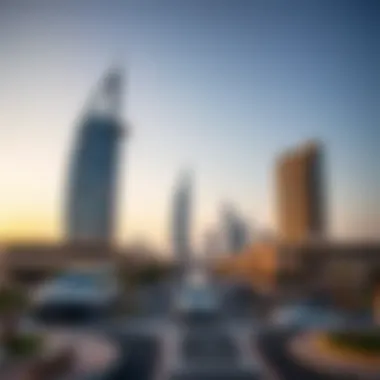

Historical context
Located in the historic Al Fahidi Fort, the Dubai Museum is an essential starting point for anyone wishing to grasp the city’s evolution from a modest fishing village to a bustling global metropolis. The museum's foundation rests upon the architecture of the fort itself, which dates back to 1787, making it the oldest existing building in Dubai. This context vividly emphasizes how the city's rich history got intertwined with its rapid modernization. The museum captures significant shifts such as the discovery of oil in the 1960s, which transformed Dubai's economy. Visitors are offered a glimpse into life before the skyscrapers and the luxury that we commonly associate with Dubai today.
This historical context is especially beneficial as it provides foundational knowledge for understanding the broader narrative of Dubai’s development.
Exhibits worth exploring
Among the exhibits, you will find life-size dioramas depicting traditional Emirati life, tools used in fishing and pearl diving, and even artifacts from ancient trade routes. One highlight is the section dedicated to the pearl diving tradition – it encapsulates the deep-rooted maritime culture of the Emirates. Additionally, visitors can marvel at various audiovisual displays that narrate Dubai's transformation through the decades.
What sets these exhibits apart is their interactivity. They allow visitors to engage by touching or even experiencing small simulations, making them a popular choice for families and education seekers alike. This approach ensures that the museum remains relevant, connecting the past with the present while inviting the audience to explore the stories of those who came before.
Al Fahidi Historical Neighborhood
Preservation initiatives
Al Fahidi Historical Neighborhood, often called Al Bastakiya, presents an engaging journey into Dubai's past without distractions of modern architecture. The preservation initiatives undertaken here are instrumental in maintaining the area’s original character while promoting cultural awareness. The aged wind-tower architecture is a key feature, a design meant to cool homes before air conditioning was an option. This sustainable building practice reminds us of the rich wisdom embedded in the local culture.
Efforts have been made to restore the surrounding souks and other significant structures, ensuring visitors can walk through history as they explore artisan shops, galleries, and cafes. These initiatives provide practical insights for investors and expats looking to delve deeper into Dubai’s dynamic cultural tapestry, highlighting how preserving the past can be beneficial for future economic opportunities.
Cultural significance
Culturally, Al Fahidi is a district that showcases traditional Emirati life and the spirit of community. Its winding alleys and courtyard homes celebrate aesthetics while serving as a physical reminder of an era gone by. Festivals and cultural events held here bring together Emiratis and expatriates alike, fostering camaraderie through shared experiences.
Moreover, the neighborhood is often viewed as a symbol of Dubai’s commitment to balancing growth and conservation. It emphasizes that modernity does not have to erase history; rather, they can coexist, contributing richly to the city’s identity.
"Al Fahidi serves as a reminder that even in a rapidly developing metropolis, the stories of the old and the new can intertwine effectively."
This cultural significance makes Al Fahidi a must-visit for anyone serious about understanding what makes Dubai tick. Through its preservation and ongoing cultural initiatives, it offers invaluable lessons in community, resilience, and heritage that resonate far beyond its borders.
Culinary Scene
Exploring the culinary scene in Dubai reveals a rich tapestry of flavors, traditions, and influences from around the globe. This aspect is vital not just to understand the city’s cultural diversity but also its social fabric. In a way, the culinary offerings in Dubai mirror its population— a melting pot of cultures eager to share their foods and culinary practices. It’s important for both tourists seeking unique experiences and investors who may look into the hospitality sector.
Local Cuisine
Traditional dishes to try
Dubai's local cuisine is a gateway into its culture and history. One cannot speak of traditional dishes without mentioning Al Harees, a dish made from wheat and meat, boiled until it reaches a porridge-like consistency. This dish, often served during festivals, is both hearty and steeped in tradition. Another staple is Shawarma, a popular street food that varies in style from the classic recipe, with chicken or lamb wrapped in pita bread alongside fresh vegetables and sauces. Such dishes are more than nutrition; they serve as a communal experience among locals and visitors alike, often enjoyed in bustling markets or food stalls.
"Food is the universal language that transcends barriers and establishes connections among diverse cultures."
The unique feature of traditional dishes in Dubai lies in their ability to provide a taste of the region's history. By trying these foods, one not only indulges in flavors but also partakes in the customs passed down through generations. However, determining where to find the best renditions can be tricky, as many establishments might offer interpretations that stray from authenticity.
Dining etiquette
Dining in Dubai is not just about the food; it involves a set of unspoken rules that show respect for the local culture. Typically, meals are served on communal plates, and it’s common for diners to share dishes. Using one's right hand for eating is considered polite, while the left is seen as reserved for less hygienic tasks. This aspect of dining etiquette adds another layer to the culinary experience, enriching one’s visit by fostering respect and understanding of local customs.
Exploring dining etiquette also highlights the dive into cultural immersion. Whether dining in a lavish restaurant or a local eatery, being aware of these practices is crucial.
International Gourmet Experiences
Top restaurants
Dubai's reputation as a foodie destination wouldn’t be complete without its top restaurants, which offer international flavors alongside local culinary gems. Fine dining establishments like Zuma and Nobu present Japanese flavors with sophistication, while places like La Petite Maison offer French cuisine made from high-quality, fresh ingredients. Interestingly, many restaurant chefs curate menus that blend their home country's traditional dishes with local flavors, creating unique fusion meals. This diversity enhances the overall dining scene and caters to various palates, attracting both food enthusiasts and general diners.
With Michelin-star establishments popping up, choosing a restaurant becomes both a culinary adventure and a reflection of one’s personal taste. This variety not only keeps Dubai's dining scene dynamic but positions the city as a culinary heavyweight globally.
Chefs and their influence
Prominent chefs play a crucial role in shaping Dubai's dining landscape. Many have drawn inspiration from their travels, leading to a culinary blend that speaks to both tradition and modernity. For instance, chef Vicky Lau, with her roots in Chinese cuisine, incorporates Dubai's spices into her dishes, infusing a familiar taste with distinct local notes.
The influence of well-known chefs in Dubai extends beyond just restaurant menus. They often drive trends in food presentation and sustainability, inspiring the next generation of culinary talents. By encouraging local produce and fresh ingredients, these chefs not only elevate the dining experience but also promote environmental awareness among diners. In essence, while food is about taste, it is also about making informed choices that support local communities.
Overall, the culinary scene in Dubai is a multifaceted experience that offers something for every palate while reflecting its rich cultural backdrop. For investors, understanding this scene can offer insights into market trends and consumer preferences, while for visitors, it opens doors to unforgettable experiences.
Shopping and Entertainment
The shoppers’ paradise of Dubai infuses multiple layers into the city’s vibrant personality. From high-end boutiques to bustling souks, shopping is not only a leisure activity but also a cultural experience. For those who have a keen eye for luxury, it’s a place where traditional markets meet the glimmer of contemporary retail.
When it comes to entertainment, Dubai does not fall short. The array of activities and events that cater to both thrill-seekers and leisurely explorers shapes the city’s allure. The significance of shopping and entertainment in this guide lies in their role as major attractions that draw visitors and potential real estate investors alike, offering both immediate and long-term engagement with the city.
Dubai Mall
Shopping variety and luxury brands
Dubai Mall stands as a beacon of style and sophistication, offering over 1,200 retail stores, including many globally recognized luxury brands. Brands like Louis Vuitton, Gucci, and Chanel find their homes in this colossal shopping space, attracting fashion enthusiasts and affluent clientele. The sheer variety found here is a compelling reason for tourists and investors to appreciate the local market landscape.
What sets the shopping experience apart is its blend of upscale fashion with cultural elements. Not just a shopping haven, it also embraces local artistry, showcasing designer boutiques from the region alongside international names. This interconnectedness provides shoppers with a unique experience, enriching their understanding of fashion’s global narrative while diving into local craftsmanship.
Aquarium and entertainment attractions
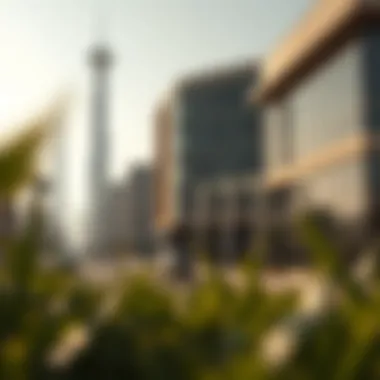

Nestled within the opulence of Dubai Mall is the Dubai Aquarium and Underwater Zoo, one of the largest suspended aquariums in the world. It boasts a vast array of marine life, allowing visitors to traverse through underwater tunnels, literally standing in awe beneath a sea of vibrant species. This attraction enhances the consumer experience, making shopping a multisensory affair where one can enjoy not just retail therapy but also engage with the wonders of the ocean.
Visitors can participate in shark diving experiences or stroll through the underwater tunnel, adding thrill to their otherwise mundane shopping trips. However, it’s essential for visitors to manage their time well, as the amount of things to see could lead to overstimulation.
Global Village
Cultural showcases
Global Village transcends typical flea markets to bring an array of cultural showcases from around the world. This seasonal attraction combines entertainment, shopping, and cultural exhibitions from various countries. Visitors can journey through different pavilions, each representing a unique culture through food, music, and crafts.
This setup fosters a deeper understanding of global traditions, creating a tapestry of experiences unique to Dubai. It’s more than just a fun outing; it serves as a platform for cultural exchange, where one can learn and appreciate the diversity that exists within the global community.
Shopping for unique items
The shopping experience at Global Village is decidedly different from traditional malls. Here, visitors can find handmade products, traditional artifacts, and souvenir items that showcase the heritage of various cultures. Each purchase supports local artisans and small businesses, thus promoting sustainable practices.
While it might not offer the same luxury brands one would find in more conventional malls, the unique items found here carry stories and personal significance—perfect for those looking to take home a slice of their travels.
Adventure and Leisure Activities
Dubai's reputation as a glimmering oasis in the desert is not limited to its skyscrapers and shopping malls. The realm of adventure and leisure activities here blends the serene and the exhilarating, offering both locals and tourists an opportunity to take a slice out of life in this vibrant city. For those looking to step out of their comfort zone or simply enjoy some downtime away from the hustle and bustle, the options available are vast and varied. From desert escapades to water sports, the city is a playground for fun seekers and thrill hunters alike. This section dives into some memorable experiences that you might want to consider during your stay.
Desert Safaris
Types of safari experiences
When you think of Dubai, one of the first images that may come to mind is the vast, rolling sands of the Arabian Desert. Desert safaris here have become synonymous with adventure tourism, providing a unique experience that goes beyond the urban confines of the city. Various types of safari experiences exist, catering to different tastes and preferences.
- Dune Bashing: Thrilling rides on a 4x4 vehicle over the undulating sandy hills.
- Camel Riding: A more traditional way to traverse the desert, offering a glimpse into the region's heritage.
- Sandboarding: Sliding down steep dunes is not only fun but also a great workout.
- Overnight Camping: Experience the desert under the stars with luxury tents, offering a taste of Bedouin life.
These experiences set the stage for unforgettable memories. Few things can compare to the rush of speed while dune bashing, feeling the wind whip around you. The sunset views from the peaks are nothing short of breathtaking. However, it’s worth considering that not all safaris are created equal; some may focus heavily on speed and thrills, while others afford a more laid-back, yet equally immersive, cultural experience. Picking the right one can shape how you connect with the landscape.
Safety and cultural awareness
While the thrill of adventure is enticing, a solid grasp of safety measures and local customs is vital for any successful excursion. Understanding cultural awareness in this context means respecting the heritage of the Bedouin tribes and acknowledging the significance of their traditions.
- Dress Appropriately: Loose, breathable clothing not only suits the climate but also aligns with local customs.
- Be Mindful of Your Actions: Behaving respectfully in public spaces speaks volumes as a visitor.
- Travel with Reputable Guides: This not only ensures safety but also enhances your experience with local insights.
This emphasis on safety creates an environment where you can fully enjoy your adventure. Missing out on recognizing cultural nuances can leave a gap in the enriching experience that Dubai offers. Without a doubt, this conscientiousness can enhance appreciation for the incredible landscape and the traditions entwined with it.
Water Sports
Popular activities
The stunning coastlines of Dubai are a playground for water sports enthusiasts, making them a compelling part of the adventure offerings. The combination of stellar weather and pristine waters creates an appealing environment for recreational activities.
- Jet Skiing: The possibility to take in the breathtaking skyline while racing through the waves.
- Wakeboarding: Perfect for those looking to catch some air while enjoying the waves.
- Scuba Diving: Exploring underwater ecosystems can be a magical experience.
- Snorkeling: A gentler alternative to diving, with many vibrant spots in and around the Palm Jumeirah.
The magic of utilizing the sea is that there's something for everyone. Whether you're a novice just looking to have fun or a seasoned pro aiming for all the thrills, it's all possible. However, keep in mind that popular activities can be crowded during peak tourist seasons, slightly affecting your experience.
Equipment rentals and safety
Engaging in water sports often means renting equipment, which begs the questions of quality and safety. Ensuring that the gear is not only up-to-date but also appropriately fitting for you makes a world of difference.
- Rental Shops: Look for ones that follow safety regulations and have a good reputation.
- Instructors: Consider hiring a trained instructor, especially if you're new to the activity.
- Life Jackets: Always ensure that life jackets are being used, regardless of your swimming skills.
When it's about safety, there doesn’t seem to be too much to consider. Diving into the world of water sports can be a fantastic way to spend your time here, but understanding the parameters of safety will allow you to focus on having fun rather than worrying about mishaps. Just remember, safety should never take a back seat to enjoyment.
Real Estate Landscape
The real estate market in Dubai is a dynamic sector that draws attention from both local and international investors. It is essential to understand the broader implications and the vitality of this market in the context of Dubai's growth story. The real estate landscape serves as a barometer for the economic health of the city. With numerous high-profile developments and an ever-expanding skyline, it's not merely about buying property; it's about investing in a lifestyle that is intimately tied to prosperity and innovation.
Investment Opportunities
Emerging areas to consider
In recent years, certain neighborhoods in Dubai have come up as hotbeds for property investment. Areas like Dubai South, which hosts the Expo 2020 site, and Dubai Hills Estate are leading the pack. These emerging locales offer a blend of modern amenities and affordability that make them attractive to first-time buyers and seasoned investors alike. A prominent aspect of Dubai South is its proximity to the new Al Maktoum International Airport, which is set to significantly boost local transit needs.
This area appeals not only for residential living but also for commercial space, making it a multifaceted option for investors seeking varied opportunities. The unique feature of Dubai Hills Estate is its green spaces and parks; it provides a refreshing contrast to the typically urban landscape of the city, catering to families and individuals prioritizing environment and wellness.
Advantages of investing in these areas include potential for appreciation as demand grows, but there can be drawbacks too, such as construction delays or unforeseen market fluctuations.
Market trends key for investors
Underpinning the real estate landscape are ongoing trends shaping the market dynamics — the rise of off-plan properties is one such trend that stands out. Investors expect healthy returns from properties that are still in the pipeline. Furthermore, ongoing government initiatives aimed at easing the purchase process for foreigners illustrate Dubai's intent to be a global real estate hub.
Notable characteristics include a strong rental market, buoyed by an ever-increasing expatriate population seeking housing, fueling demand for rental properties. What sets this trend apart is the post-pandemic performance; there’s been a notable recovery with property sales gaining momentum as people reassess their living situations.
However, investors need to be wary of potential pitfalls, such as interest rates affecting mortgage amounts, necessitating prudent financial planning.
Expat Living
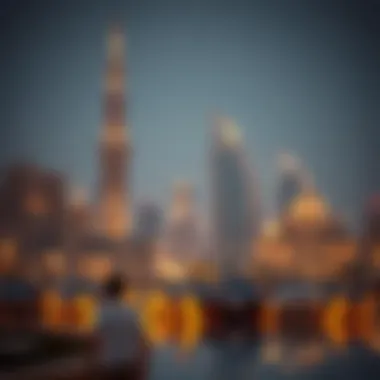

Residency options
Dubai offers various residency options for expatriates, making it a welcoming choice for those looking to settle down. The introduction of long-term visas, such as the Golden Visa, has opened doors for investors, entrepreneurs, and even students pursuing education in Dubai. This residency option not only provides security for expatriates but also encourages investment in the local economy.
Additionally, the flexibility tied to job sponsorships enables individuals to stay in Dubai while maintaining their professional ties, further enhancing their living experience.
A unique feature of these options is their ease of access; the process is streamlined for those looking to relocate for work or family purposes.
Cost of living insights
Cost of living in Dubai varies widely depending on lifestyle choices and neighborhoods. High-end areas like Downtown Dubai come with luxury price tags, while suburbs such as Jumeirah Village Circle (JVC) offer more affordability. A key characteristic of living costs is the lack of income tax, which positively influences disposable income compared to many other cities. This can be a boon for expatriates, allowing them to enjoy a higher standard of living without the usual tax burdens.
Yet, potential drawbacks include fluctuating rental prices and the overall cost of day-to-day living, which can bite into budgets. Ultimately, becoming aware of these factors helps newcomers to budget and manage expectations.
"Dubai's real estate sector is a symphony of opportunities for those willing to participate. With careful consideration and strategic investment, the landscape can be navigated successfully."
Understanding the real estate landscape in Dubai goes beyond the mere buying and selling of property; it's a gateway into experiencing the vibrant essence of life in this remarkable city. Investors and expatriates alike benefit from grasping the nuances that embody this multifaceted environment.
Transport and Connectivity
The realm of Transport and Connectivity in Dubai is paramount to understanding how this city operates and thrives. Given its rapid growth and international status, having a reliable and efficient transportation system is key. This section will explore various elements that lay the groundwork for smooth travels, both for residents and visitors alike.
Public Transport System
Metro and bus services
Dubai's Metro system is an impressive feat of engineering, stretching over 75 kilometers, connecting communities across the city seamlessly. This mass transit option has proven to be a game-changer in the city. Instead of searching endlessly for parking or getting caught in the infamous traffic jams, folks can just hop on the train.
The metro trains run on an automated system, meaning they are punctual and efficient. With multiple lines crisscrossing the city, it allows access to places like the Dubai Mall and Burj Khalifa quickly and easily. Alongside the metro, the bus system complements it perfectly, covering areas not served by the metro tracks. The buses are air-conditioned, which is a blessing against the stifling heat.
One unique feature of these services is the Nol Card, which allows users to pay for metro and bus rides with a single card. Advantages? You can load it up, and off you go — no need for loose change. But, like most systems, there are drawbacks such as occasional overcrowding during peak hours, which can be a hassle for commuters.
Advantages for commuters
So, what makes using public transport such a wise choice for travel in Dubai? Primarily, it's the cost-effectiveness. Instead of shelling out bucks for taxis every time, using public transport could save considerable amounts over time. Moreover, it’s a sustainable choice; reducing the carbon footprint is no small matter when you're talking about traffic-heavy cities.
Commuters benefit significantly in terms of accessibility. Many stations are equipped with facilities for those with mobility issues, catering to a broader audience. And while the Dubai Metro is generally safe, it's good to keep one's belongings close and be aware, like in any bustling city.
Having several links between metro lines and bus routes creates a robust web of transport that keeps the city moving, making public transport an invaluable piece of Dubai’s urban puzzle.
Airport Accessibility
Dubai International Airport
When it comes to airport services, Dubai International Airport (DXB) is a central hub for international travel. Strikingly efficient, it handles millions of passengers each year, famed for its luxurious lounges and myriad shopping options. Whether you're departing or arriving, the airport provides top-notch services that cater to both leisure and business travelers.
Unique to DXB, the sheer size and scale make it the busiest international airport in the world. From automatic gates to a plethora of amenities, it aims to provide a seamless experience for travelers. The convenience factor cannot be overstated; having hotels on-site makes it easier for long layovers, allowing travelers to freshen up or even have a quick nap.
However, like many big airports, delays during peak travel times can be an issue, although the amenities usually soften the experience.
Flight connectivity to global destinations
Flight connectivity is another feather in Dubai’s cap. With airlines like Emirates and Etihad at the forefront, direct flights to nearly every corner of the globe are not a mere suggestion — they are a reality. Most regional and international travelers find it a breeze to hop on and off to major cities worldwide, making Dubai an attractive stopover for many.
The unique feature of this connectivity is the extensive route network that allows travelers to easily access markets in Asia, Europe, and Africa. Likewise, the efficiency of frequent flights means that business travelers can maximize their time significantly. Yet, it should be noted that such advantages sometimes come at a cost, as flight prices can soar during peak seasons.
Consequently, Transport and Connectivity in Dubai are not just essential for local residents but are part of what makes this city such an attractive destination for investment and tourism alike. Effective transport links can drive economic growth and enhance the quality of life for individuals.
It's clear that without a robust transport system, even the most stunning architectural designs and culinary experiences can’t be enjoyed to their fullest.
For detailed info, you can explore more at Dubai Public Transport or check out Dubai International Airport.
This allows us to see how integral transport systems are in reflecting the lively landscape of Dubai.
Safety and Regulations
Navigating the intricate layers of Dubai's vibrant landscape involves understanding the framework that governs daily life. Safety and regulations are paramount, ensuring that residents and visitors alike can enjoy their experiences without fear. Dubai, known for its juxtaposition of modernity and tradition, boasts a legal system influenced by Islamic law infused with elements of civil law. This unique blend ensures a stable environment where mutual respect is emphasized and, ultimately, makes the city an attractive destination for expatriates and investors alike.
The city is often hailed for its exceptionally low crime rate, a phenomenon that is born from strict law enforcement and community engagement. It's not just about laws on the books; it's about creating a conscientious society where norms are respected. Furthermore, understanding the regulations surrounding business operations, residency, and personal conduct is crucial for anyone looking to thrive in this dynamic environment.
"Doing business in Dubai isn't just about making profits; it's about understanding the cultural and legal landscape that makes everything tick."
Understanding Local Laws
Cultural norms and practices
Cultural norms in Dubai are a tapestry woven from its rich heritage and diverse expatriate influences. The Islamic traditions play a significant role in shaping societal interactions, especially in public spaces. For instance, it's common to greet individuals with a handshake and respect for personal space is paramount. The expectation of modesty in attire while in public settings is another norm that reflects the cultural landscape.
These practices contribute significantly to fostering a respectful and harmonious environment. Being attuned to such nuances can be beneficial, especially for visitors who might come from more liberal cultures. Understanding these norms not only aids travelers in navigating social situations but also fosters goodwill and cooperative relationships.
However, the unique feature is the coexistence of various international practices within the expatriate community. This blending opens avenues for cultural exchange, allowing individuals to celebrate the rich diversity while adhering to the foundational norms of the host society. The challenge lies in balancing personal freedoms with the local ethos, but successful navigation can lead to rewarding experiences.
Legal considerations for expatriates
The legal framework for expatriates in Dubai is both comprehensive and intricate. For those considering a move to the UAE, understanding the residency laws is essential. The process of acquiring residence visas, work permits, and adhering to the local labor laws requires diligence. Such regulations ensure that expatriates are legally recognized and can engage in various economic activities.
One key characteristic about legalities in Dubai is transparency, which is regarded as a beneficial trait. For instance, knowing the requirements for business licensing can streamline operations for new ventures. Moreover, awareness of personal conduct laws—such as restrictions on public behavior, food during Ramadan, and alcohol consumption—can prevent legal mishaps.
However, a unique aspect is the relatively rapid changes in regulations aimed at fostering a business-friendly environment. While this dynamism can be an advantage for investors seeking new opportunities, it also necessitates staying updated on the latest legal shifts to circumvent potential pitfalls.
In summary, understanding both the cultural norms and legal legalities is imperative for anyone looking to fully immerse themselves in the Dubai experience. Gaining insight into these facets can pave the way for richer interactions, safer living, and more prudent investments.

